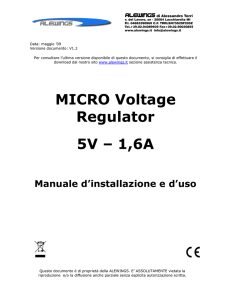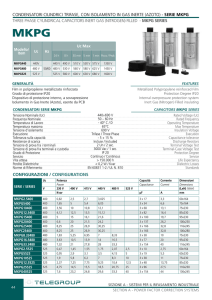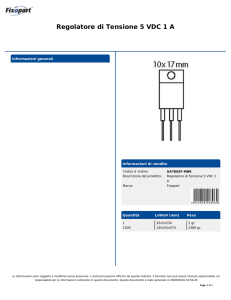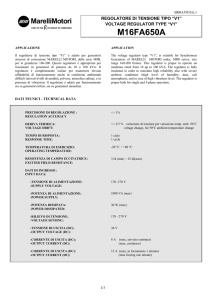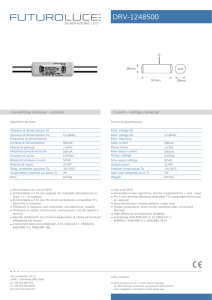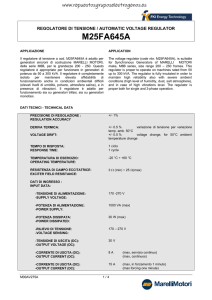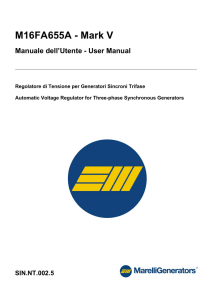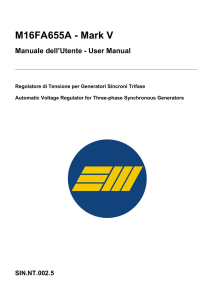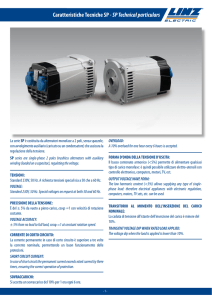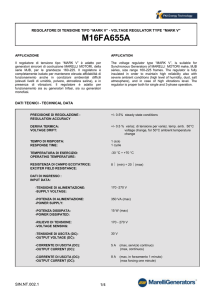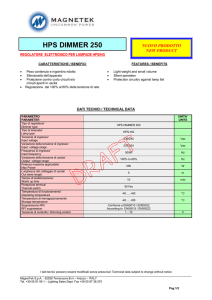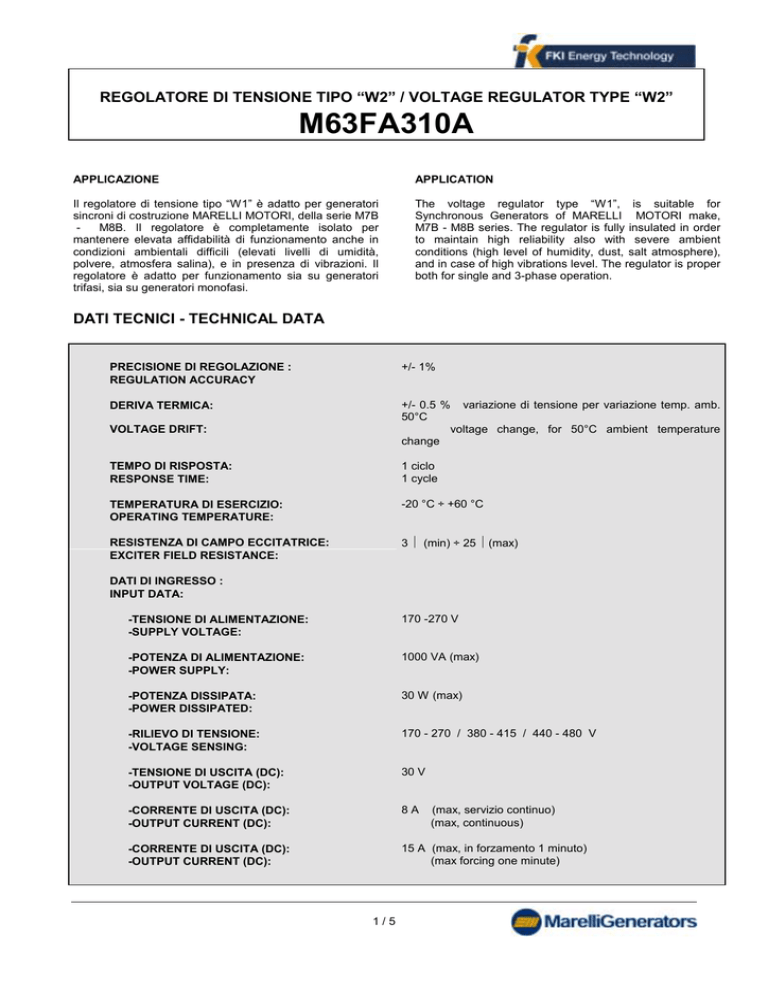
REGOLATORE DI TENSIONE TIPO “W2” / VOLTAGE REGULATOR TYPE “W2”
M63FA310A
APPLICAZIONE
APPLICATION
Il regolatore di tensione tipo “W1” è adatto per generatori
sincroni di costruzione MARELLI MOTORI, della serie M7B
M8B. Il regolatore è completamente isolato per
mantenere elevata affidabilità di funzionamento anche in
condizioni ambientali difficili (elevati livelli di umidità,
polvere, atmosfera salina), e in presenza di vibrazioni. Il
regolatore è adatto per funzionamento sia su generatori
trifasi, sia su generatori monofasi.
The voltage regulator type “W1”, is suitable for
Synchronous Generators of MARELLI MOTORI make,
M7B - M8B series. The regulator is fully insulated in order
to maintain high reliability also with severe ambient
conditions (high level of humidity, dust, salt atmosphere),
and in case of high vibrations level. The regulator is proper
both for single and 3-phase operation.
DATI TECNICI - TECHNICAL DATA
PRECISIONE DI REGOLAZIONE :
REGULATION ACCURACY
+/- 1%
DERIVA TERMICA:
+/- 0.5 % variazione di tensione per variazione temp. amb.
50°C
voltage change, for 50°C ambient temperature
change
VOLTAGE DRIFT:
TEMPO DI RISPOSTA:
RESPONSE TIME:
1 ciclo
1 cycle
TEMPERATURA DI ESERCIZIO:
OPERATING TEMPERATURE:
-20 °C ÷ +60 °C
RESISTENZA DI CAMPO ECCITATRICE:
EXCITER FIELD RESISTANCE:
3 Ω (min) ÷ 25 Ω(max)
DATI DI INGRESSO :
INPUT DATA:
-TENSIONE DI ALIMENTAZIONE:
-SUPPLY VOLTAGE:
170 -270 V
-POTENZA DI ALIMENTAZIONE:
-POWER SUPPLY:
1000 VA (max)
-POTENZA DISSIPATA:
-POWER DISSIPATED:
30 W (max)
-RILIEVO DI TENSIONE:
-VOLTAGE SENSING:
170 - 270 / 380 - 415 / 440 - 480 V
-TENSIONE DI USCITA (DC):
-OUTPUT VOLTAGE (DC):
30 V
-CORRENTE DI USCITA (DC):
-OUTPUT CURRENT (DC):
8A
-CORRENTE DI USCITA (DC):
-OUTPUT CURRENT (DC):
15 A (max, in forzamento 1 minuto)
(max forcing one minute)
1/5
(max, servizio continuo)
(max, continuous)
REGOLATORE DI TENSIONE
M63FA310A
P3
VOLTAGE REGULATOR
M63FA310A
P1
P2
RDT - AVR
P
Q
60
1
Hz
2
3
4
5
P4
A
B
6
8
M
+
+
TERMINALI
TERMINALS
Le connessioni sono realizzate per mezzo di terminali di
tipo FAST-ON. I terminali devono essere collegati secondo
gli schemi applicabili, in modo da evitare ogni possibile
errore di utilizzo. L’uso dei terminali di tipo FAST-ON rende
semplice qualsiasi operazione sul regolatore dei tensione
(quali sostituzione, collegamento con accessori, tarature).
Connection terminals are performed through FAST-ON
terminals. The terminals have to be connected according
the applicable wiring diagram, in order to avoid any
possible mistake in the wiring. The use of FAST-ON
terminals makes
any operation on regulator (as
replacement, connection to accessories, setting up)
extremely simple.
TERMINALI DI INGRESSO DI POTENZA
POWER STAGE INPUT TERMINALS
“0” , “U” : terminali di alimentazione di potenza
“0” , “U” : terminals for power supply
TERMINALI DI INGRESSO DI RILIEVO TENSIONE
VOLTAGE SENSING INPUT TERMINALS
“U” (terminale comune per alimentazione di potenza e
rilievo), 230, 300, 400 V
“U” (common terminal for power supply and voltage
sensing), 230, 300, 400 V
TERMINALI DI USCITA
OUTPUT TERMINALS
“+” - “-”: terminali per l’alimentazione del campo eccitatrice
“+” , “-” : output terminals (positive, DC, and negative, DC)
TERMINALI DI CONTROLLO
CONTROL TERMINALS
“Hz” , “60” : terminali per modifica della protezione di bassi
giri terminali
“P” , “Q” : terminali per il collegamento di un trimmer
esterno
“6”, “8”: terminali per ingresso di controllo a mezzo di
sistemi esterni (ingresso per tensione continua, +/-3 Vdc).
Il terminale “M” è da utilizzare solo per collegamenti
particolari.
“Hz” , “50” : terminals for changing the low speed
protection terminals
“P” , “Q” : terminals for connection of external trimmer
“6”, “8”: input terminals for connections of external control
systems (input for D.C. voltage , +/-3 Vdc). The terminal
“M” is to be used only in case of special connections.
TERMINALI di interconnessione con dispositivo di
sovraeccitazione
TERMINALS for interconnecting with overboosting
excitation systems
“+” - “-”: terminali per l’alimentazione del campo eccitatrice;
terminale 9 per controllo di tensione
“+” , “-” : output terminals (positive, DC, and negative, DC);
terminal 9 for voltage sensing
2/5
P3
ON
P
Q
60
1 2
3 4
5
O FF
Hz
A
B
POTENZIOMETRO ESTERNO
EXTERNAL POTENTIOMETER
Agli ingressi “P” e “Q” può essere collegato un
potenziometro esterno di potenza minima 2W e di
resistenza circa 1000 Ohm. Con tale reostato si ottiene
possibilità di regolazione della tensione di circa +/-5%
attorno al valore nominale. Utilizzando resistenza di circa
2000 Ohm è possibile ottenere una possibilità di
regolazione di circa +/-10%.
Il potenziometro risulta
comunque collegato attraverso il regolatore di tensione
alla sorgente di alimentazione del regolatore stesso e
quindi il resistore del potenziometro può risultare sotto
tensione.
At the terminals “P” and “Q” an external trimmer (minimum
rating 2 W, resistance abt 1000 OHM can be connected,
after having removed the bridge which normally shorts the
terminals “P” and “Q”. By acting on such trimmer, it is
possible to obtain a voltage regulation of abt +/- 5 %
around the nominal voltage. By using a 2000 OHM
potentiometer it is possible to obtain a voltage regulation of
abt +/- 10 %. The trimmer is connected anyway (through
the regulator) to the output of the generator and then it
represents a live part.
USO DEI POTENZIOMETRI
USE OF POTENTIOMETERS
-P1- potenziometro per regolazione della tensione di uscita
del generatore; tale potenziometro interno permette la
regolazione in un campo molto esteso di tensioni, ad es.
tra 350 e 470 V, oppure tra 170 e 260 V. Per ottenere una
regolazione più fine della tensione (o per regolare la
tensione dal pannello di controllo, oppure per limitare il
campo di variazione della tensione) è possibile inserire un
potenziometro esterno tra i terminali ”P” e “Q” (resistenza
circa 1000 Ohm, 2 W, per ottenere una possibilità di
regolazione +/-5%).
-P1- potentiometer for adjusting the output voltage of the
generator: the voltage adjust possibility depends on the
characteristics of the generator. Normally the internal
potentiometer P1 allows possibility of adjusting the voltage
in a wide range (i.e. between 350 and 470 V, or between
170 and 260 V); to obtain a finer possibility of voltage
setting or to adjust the voltage from the control panel, or in
order to limit the voltage range, an external potentiometer
can connected to the terminal “P” and “Q” (resistance abt
1000 Ohm, 2 W, to obtain +/- 5% voltage regulation).
-P2- potenziometro per la taratura della protezione di bassi
giri. Tale potenziometro è normalmente regolato in
fabbrica in modo da ridurre l’eccitazione qualora la velocità
del generatore venga ridotta al di sotto del 90% della
velocità nominale a 50 Hz. Togliendo il ponticello
normalmente presente tra i terminali “Hz” e “60” la
protezione per bassi giri agisce in modo appropriato per
funzionamento a 60 Hz.
-P2- potentiometer for changing the low speed protection.
Usually it is set at the factory in order to reduce the
excitation when speed becomes lower than 90% of rated
speed at 50 Hz. By removing the bridge which normally
shorts the terminals “Hz” and “60”, the speed protection
acts properly fo 60 Hz operation.. By acting on
potentiometer P2 it is possible to adjust further (in case
should it be necessry) the frequency at which the lowspeed protection is effective.
-P3- potenziometro per la taratura della stabilità:
ruotandolo in senso orario la stabilità del regolatore di
tensione aumenta, però il tempo di risposta diventa più
lungo.
-P3- stability potentiometer: by rotating it clockwise stability
increases, but response time becomes larger.
3/5
PROTEZIONE PER BASSI GIRI
LOW SPEED PROTECTION
Il regolatore è provvisto di circuiti interni che provocano la
riduzione della corrente di eccitazione, qualora il
generatore sia utilizzato a bassa velocità, per evitare
danni al sistema di eccitazione del generatore (cioè al
regolatore o al circuito di campo principale etc.). Il
potenziometro “P2” permette di regolare la frequenza al di
sotto della quale la protezione comincia ad intervenire: al
di sotto di tale particolare frequenza il regolatore riduce in
modo molto sensibile la tensione di uscita del generatore
(la riduzione di tensione è circa doppia rispetto alla
variazione di velocità). Ponendo il microswitch numero 3 in
posizione OFF, è possibile avere una diminuzione meno
sensibile, all’incirca proporzionale alla frequenza.
The regulator is provided with internal circuits in order to
reduce the excitation, when running at low speed, in order
to avoid damages to the excitation devices system of the
generator (i.e. to the regulator, to exciter field, to rotating
rectifier, main rotor). The potentiometer “P2”, fixes the
corner-frequency, that is the frequency at which that
internal circuitry becomes effective on external voltage.
Below that particular frequency the voltage of the
generator reduces further with speed reduction (voltage
reduction is twice the reduction in speed).
By setting the microswitch nr. 3 in OFF position, the
voltage reduction is smaller (the voltage reduction is close
to be proportional to the speed reduction).
TARATURA DELLA STABILITA’
STABILITY SETTING
Il regolatore di tensione è provvisto di circuiti interni
regolabili per permettere il funzionamento in un ampio
campo di applicazioni. Il funzionamento del regolatore può
essere modificato sull’impianto in modo da adattare le
caratteristiche del regolatore stesso al tipo di impianto e
alle caratteristiche del motore primo (motore diesel, turbina
idraulica, turbina a gas), in modo da ottenere la migliore
risposta in tensione. Per modificare le caratteristiche di
stabilità del regolatore è necessario agire sul
potenziometro “P3”: tale potenziometro permette una
regolazione fine della stabilità.
La stabilità può essere ulteriormente modificata in modo
grossolano a mezzo dei microswitch 1 e 2.
The voltage regulator is provided with internal adjustable
stability circuits in order to allow operation in a wide range
of applications. The operation of the regulator can be set
on field to adapt it to the characteristics of the plant and of
the driving engine (diesel engine, water turbine, gas
turbine) in order to obtain the best voltage response. To
change the stability characteristics of the regulator, it is
necessary to act on the potentiometer “P3” (for fine setting
of stability).
An additional coarse setting of stability can be achieved by
means of the microswitches number 1 and 2 (when in “ON”
position the regulation system becomes slower):
DISPOSITIVO DI STATISMO
DROOP KIT DEVICE
APPLICAZIONE
APPLICATION
Il dispositivo è incluso nel regolatore di tensione per
consentire il funzionamento in parallelo tra generatori di
caratteristiche similari. Il dispositivo permette di
suddividere correttamente la potenza reattiva richiesta dal
carico tra i vari alternatori collegati in parallelo.
Il dispositivo è composto da un trasformatore esterno di
corrente (che rileva la corrente nella fase “W”), e da un
circuito di “statismo”, interno al regolatore.
Il regolatore è provvisto di terminali di ingresso adatti per
un facile collegamento al trasformatore di corrente
(terminali “A” e “B”. Tali terminali sono normalmente
cortocircuitati da un ponticello metallico, quando il
generatore è utilizzato in isola.
The device is included in the voltage, to allow parallel
operation between similar generators: the device permits
to share correctly the total reactive power required by the
load among all generators operating in parallel. The device
is composed by an external current transformer (which is
sensing the the current in phase W) and by a “droop”
circuit internal in the regulator.
The voltage regulator is provided with input terminals
(terminals “A” and “B”) for easy connection to current
transformer. Such terminal are normally short-circuited by
a bridge, when the generator is used in single operation.
P
Q
60
1
2
Hz
3
4
P4
A
B
6
8
M
4/5
5
TRASFORMATORE DI CORRENTE
CURRENT TRANSFORMER
Il trasformatore di corrente per il rilievo della corrente di
uscita del generatore è normalmente inserito sulla fase
“W” ed è di caratteristiche seguenti:
-potenza nominale: 5VA
-rapporto di trasformazione: corrente nominale a
secondario 1 A
I terminali di uscita del trasformatore di corrente sono
collegati ai morsetti A e B.
The current transformer for current detection is rating as
follows:
-rated power: 5 VA
-ratio:rated current to 1 A)
The transformer has to be connected at the terminals A
and B.
FUNZIONAMENTO
OPERATION
Il dispositivo di parallelo, utilizzato assieme al regolatore di
tensione, rileva la corrente reattiva erogata dal generatore
a cui è collegato e provoca una caduta di tensione, ai
morsetti del generatore, proporzionale alla corrente
reattiva rilevata. Per ottenere la corretta ripartizione della
potenza reattiva tra generatori funzionanti in parallelo
occorre:
- che tutti i generatori presentino la stessa tensione a
vuoto
- che tutti i generatori presentino una identica caduta di
tensione in funzione della potenza reattiva: occorre cioè
che tutti i generatori, provati separatamente sul medesimo
carico reattivo, presentino la stessa caduta permanente di
tensione tra vuoto e carico.
Based on the level of current detected by the current
transformer, the regulation system assures a voltage
reduction (on output terminals of the generator) which is
proportional to the reactive power supplied by the
generator.
The correct sharing of reactive power is based on identical
droop on all machines which are to operate in parallel:
that is, in order to permit a correct sharing, all generators
tested separately on reactive load must show the same
reduction on output voltage from no load to full load.
TARATURE
SETTING
La caduta permanente di tensione (in funzione della
corrente reattiva), può essere variata agendo sul
potenziometro interno P4, del regolatore di tensione.
La caduta di tensione, qualora il dispositivo di statismo sia
fornito assieme al generatore, è normalmente regolato in
modo da ottenere una caduta permanente di tensione pari
al 4%, passando da vuoto a pieno carico a cosfi=0.8. Il
dispositivo è comunque normalmente fornito con un
ponticello di cortocircuito tra i morsetti A e B, in modo che
il dispositivo di statismo non sia inserito. Nel caso che il
generatore funzioni in parallelo con altri generatori è
necessario rimuovere tale ponticello di cortocircuito.
Per verificare il corretto funzionamento del dispositivo, il
generatore deve essere provato singolarmente su un
carico preferibilmente reattivo, dopo aver levato il
ponticello tra A e B.: la tensione di uscita del generatore
deve diminuire con l’aumentare del carico: se la tensione
tende invece ad aumentare, occorre allora scambiare i due
terminali del trasformatore di corrente ai morsetti A e B.
Qualora il generatore sia provato su carico attivo, le cadute
di tensione sono praticamente trascurabili.
The voltage droop is set by acting on the internal
potentiometer P4 on the regulator.
The voltage droop (in case the droop kit device is supplied
with the generator) is normally set in order to obtain a
voltage reduction of 4%, when passing from no load to full
load, power factor 0.8. : the machine is anyway supplied
with a bridge between the terminals A and B, thus the
droop kit device is out of operation
In case the generator has to operate in parallel operation
with other generators, the bridge across the terminals A
and B has to be removed.
To check the correct operation of the droop kit device, the
generator has to be tested in single operation on reactive
load, after having taken out the bridge A-B.: the output
voltage of the generator must decrease as far as the load
increases; in case the voltage should increase instead of
reducing, then the two terminals of the current tranformers
have to be reversed at the terminals A and B.
In case the generator is tested with active load, droop
voltage is negligibile.
5/5

